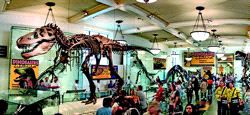LFP - Large-Format-Printing
What Your Business Can Learn From Museum Exhibits-FASTSIGNS

Tuesday 24. September 2013 - There's something uniquely memorable about a trip to the museum. Strolling past ancient artifacts with wide-eyed wonder, the general public would have no idea how much went on behind the scenes to lead up to a successful opening. But the fact is, a ton of hard work and innovative design principals on the part of museum curators contributed to an interactive learning experience that is both fun and easy to navigate. These same principals can be applied to your business environment to help transform your space and elevate the experience for you customers. Read on for some easy-to-implement strategies for creating your own crowd-drawing exhibits.
Make Your Space Educational
Museums are in the business of mind enrichment but that doesn’t mean a business can’t adopt the same educational sales angle. It’s a powerful tool. Consumers want to feel connected to your brand to know the people and the history behind it, or be the first to know about a new product or release.
When customers are willing to listen, you have a unique opportunity to serve up compelling, engaging and highly interactive content. This two-way dialogue fosters long-term brand loyalty. Food brands as an example have a tremendous opportunity to help educate people on smart dietary choices. People already want to know. Ask yourself what questions a person might have about your brand. Then deliver that information in a helpful and unobtrusive way.
Make it Immersive
A museum is a place to explore, discover and learn. Often times highly visual elements help immerse people in the subject matter. Think about high-impact visuals that would support your brand in a creative way. Similarly, décor, lighting and music also enhance a person’s experience within a defined space. Museums often use incandescent lamps, fiber optic and HID lighting to highlight specific pieces and achieve certain visual affects. How can you use lighting in your environment to accent or emphasize a particular area.
If you want to incorporate music, try something that supports your brand creatively. For example, a running store might play a loop of upbeat, high-energy music with digital signage featuring race or videos or someone training for a race. Lastly, create ambient signage a simple, eye-catching visual with few or no words that does nothing more than convey a mood associate with your brand. Even if you’re limited in the scope of what you can do in your space, be cohesive with the elements.
Make Interactive
Museums today have raised the bar on creating highly memorable and interactive experiences. The Fernbank NatureQuest in Atlanta is a great example of how interactivity and hands-on experiences literally transform children into explorers and scientists. For businesses, digital kiosks let visitors explore and interact with your brand even get some first hand experience with your products.
Museum exhibits have the pathway to discovery down to a science, and by utilizing some of their time-tested strategies you can draw large crowds and keep people captivated with your brand.
